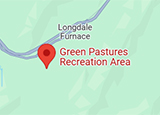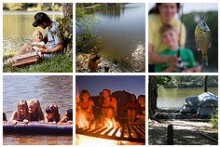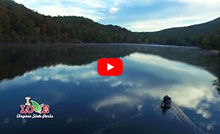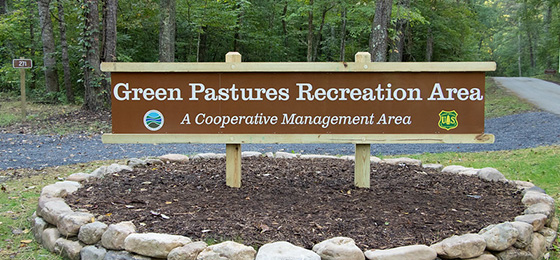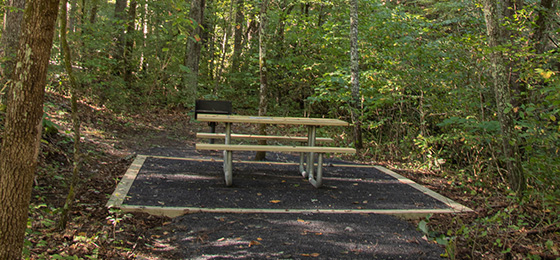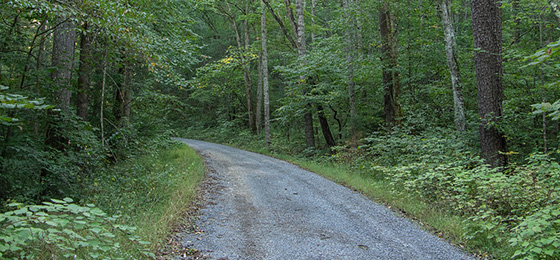Green Pastures Recreation Area
201 Green Pasture Trail, Clifton Forge, VA 24422; Phone: 540-862-8100; Email: douthat@dcr.virginia.gov
Latitude, 37.788602968499. Longitude, -79.70307260716.

Closed November 1- April 30, walk-in during this time is permissible. Please do not block the main gate.
Green Pastures Recreation Area is within the George Washington National Forest and is open for day use. It includes hiking and biking trails, a picnic area and restrooms.
General Information
Green Pastures (Longdale) Recreation Area was built for use by African Americans during the segregation era, although it was officially integrated in 1950. The recreation area within the George Washington National Forest included a small lake with a sandy beach, a bathhouse, picnic shelter, toilet facilities, playing fields, hiking trails, walking paths, and parking areas, all built by the Civilian Conservation Corps during the Great Depression. The name of the area was changed to Longdale in 1964. Green Pastures was meant to pair with the six Virginia State Parks sites opened in 1936, including nearby Douthat State Park built by the CCC. Though not legally mandated, these Virginia State Parks sites were effectively whites-only.
An NAACP-led campaign resulted in a meeting between federal and state land-management agencies (USDA Forest Service, National Park Service, Virginia State Parks, & the Virginia Department of Forestry). The USDA Forest Service agreed to host an African American recreation area. While open, Green Pastures was undoubtedly the first and only African American USDA Forest Service recreation site within Virginia and, likely, the only of its kind nationwide. It was also one of the few outdoor recreational areas open to African Americans in the central Appalachian region from the 1930s through the 1950s.
The reopening and dedication of the Green Pastures Recreation Area and historic signing of a Shared Stewardship agreement between the U.S. Department of Agriculture and the Commonwealth of Virginia took place on Friday, September 24, 2021. Douthat State Park now manages the recreation area.
Hours
The grounds are open from Dawn to Dusk. May 1- Oct. 31
Location
From I-64 Take Exit 35 for VA-269/State Route 850 toward Longdale Furnace. Turn onto VA-269W toward Longdale Furnace Road. Continue for 2 miles. Turn left onto Tri-county Road. Slight right onto Green Pasture Trail.
From Clifton Forge, head east on US-60 Business E/Main St, turn right onto Longdale Furnace Rd, continue onto VA-269 E/Longdale Furnace Rd, turn right onto Tri County Rd, slight right onto Green Pasture Trail, and follow it to the parking area.
Park Size
133 acres
Share this page
Cabins, camping
OVERNIGHT FACILITIES
None - day use only, but see Douthat State Park for overnight camping and cabin facilities near this park. For information on the availability of other parks' overnight accommodations and particular park amenities or to make a reservation, you can reserve online or call 1-800-933-PARK. See park fees.
Recreation
TRAILS
Green Pastures Recreation Area has over 8 miles of hiking and biking trails that connect to trails in the USFS.
SWIMMING
While swimming isn't available at this park, you can take a short trip to nearby Douthat State Park, where you can enjoy this amenity.
FISHING, BOATING
Green Pastures has a small lake for fishing as well as Blue Suck Run. All DWR fishing regulations apply. No boating at this park.
HORSES
None at this park.
Park Trail Guide
Click here for the park's trail guide.
Download (external link for use with Avenza App) the geo-referenced map
Download the geo-referenced map for this park
Nearby Attractions
Within an hour's drive of Green Pastures Recreation Area you will find:
Alleghany County: Visit the Arts and Crafts Center, the Historic Stonewall Theater and the C&O Historical Society Archives in the Railroad Museum in downtown Clifton Forge. Further west is Virginia’s oldest standing covered bridge on Rt. 60, west of Covington. Travel Rt. 220, north of Covington and find Falling Springs, described by Thomas Jefferson as a "remarkable cascade . . . falling over a rock about 200 feet to the valley below."
Bath County: Visit the Garth Newel Music Center, the Warm Springs Baths and the Bath County Historical Society Museum. Bath County is the home of The Homestead, a National Historic Landmark covering 15,000 acres. Horseback riding, skeet shooting, golf and many other activities abound.
Lexington: The home of Natural Bridge, one of the seven natural wonders of the world. Nearby is the Natural Bridge Zoo. Lexington is also home to the Virginia Military Institute, Washington and Lee University, Safari Park and the Virginia Horse Center. Civil War history abounds throughout this historic town.
Staunton, Waynesboro: Take a trip back in time and visit the Museum of American Frontier Culture. Also visit the Woodrow Wilson Presidential Library and Museum and historic Mary Baldwin College. Country and gospel music fans won't want to miss the Statler Brothers Museum complex. Also be sure to visit the museum of renowned artist P. Buckley Moss. Take in a fresh, energetic approach to Shakespeare at the American Shakespeare Center, which has the only re-creation of Shakespeare's indoor theater.
Roanoke: While in Roanoke, visit the Science Museum, Center in the Square, the Planetarium, the Museum of Transportation, the Explore Park, Mill Mountain Zoo and the market area in downtown Roanoke. Also be sure to tour the Dixie Caverns.
White Sulphur Springs, W. Va.: The Greenbrier, nestled in 6,500 acres of the Alleghany Mountains, features golf, tennis, horseback riding, mineral baths and spacious accommodations.
Picnic Shelters
The park has one historic CCC-built picnic shelter. Picnic tables and restrooms are also available.
Meeting Space and Facilities
MEETING FACILITIES
None at this park.
VISITOR CENTER, GIFT SHOP
None at this park.
RESTAURANT
None at this park.
LAUNDRY
None at this park.
ENVIRONMENTAL EDUCATION CENTER
None at this park.
SPECIAL FEATURES
The historic CCC-built picnic shelter and access to United States Forest Service (USFS) trails.
Other Info
NATURE, HISTORY PROGRAMS
View all parks' events, festivals, workshops and interpretive programs.
CONCESSIONS
None at this park.
HISTORY
Green Pastures (Longdale) Recreation Area was built for use by African Americans during the segregation era, although it was officially integrated in 1950. The recreation area within the George Washington National Forest included a small lake with a sandy beach, a bathhouse, picnic shelter, toilet facilities, playing fields, hiking trails, walking paths, and parking areas, all built by the Civilian Conservation Corps during the Great Depression. The name of the area was changed to Longdale in 1964. Green Pastures was meant to pair with the six Virginia State Parks sites opened in 1936, including nearby Douthat State Park built by the CCC. Though not legally mandated, these Virginia State Parks sites were effectively whites-only.
An NAACP-led campaign resulted in a meeting between federal and state land-management agencies (USDA Forest Service, National Park Service, Virginia State Parks, & the Virginia Department of Forestry). The USDA Forest Service agreed to host an African American recreation area. While open, Green Pastures was undoubtedly the first and only African American USDA Forest Service recreation site within Virginia and, likely, the only of its kind nationwide. It was also one of the few outdoor recreational areas open to African Americans in the central Appalachian region from the 1930s through the 1950s.
FRIENDS GROUP
Douthat Friends group
